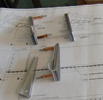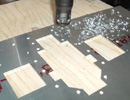


random user submitted photo
Why castle nuts and cotter pins?
3 posts
• Page 1 of 1
Why castle nuts and cotter pins?
Greetings,
As I rebuilt some mistakes from the previous builder on the aileron paddles, I'm going to be finalizing the linkage for the ailerons and flaps. The plans show drilled bolts and castle nuts everywhere, which makes no sense to me. For the bolts that connect a rod end bearing to another assembly, the bearing is the rotating part, not the bolt. It seems more proper to me to torque the bolt with a friction nut since the bolt isn't meant to rotate. The only thing I can guess is that they want the bolt to be able to turn if the bearing freezes up?
Is everyone just doing it like the plans show without question?
Thanks,
Rusty
As I rebuilt some mistakes from the previous builder on the aileron paddles, I'm going to be finalizing the linkage for the ailerons and flaps. The plans show drilled bolts and castle nuts everywhere, which makes no sense to me. For the bolts that connect a rod end bearing to another assembly, the bearing is the rotating part, not the bolt. It seems more proper to me to torque the bolt with a friction nut since the bolt isn't meant to rotate. The only thing I can guess is that they want the bolt to be able to turn if the bearing freezes up?
Is everyone just doing it like the plans show without question?
Thanks,
Rusty
Rusty
Onex- Rotax 912 (130 hours and counting)
Fixed wing, gyroplane, A&P
Onex- Rotax 912 (130 hours and counting)
Fixed wing, gyroplane, A&P
- 13brv3
- Posts: 441
- Joined: Fri Sep 25, 2015 11:59 am
- Location: Tellico Plains, TN
Re: Why castle nuts and cotter pins?
As per 43:13, ANY bolt subjected to rotational forces (whether intentional of not) is to be secured with a cotter pin. You can't go wrong following the Methods and Practices 'bible' concerning aircraft construction and/or repair.
The Heim bearing is 'supposed'' to take the rotational force, however in the event of bearing seizure the bolt then starts turning.
Probable? Maybe not. But the key word here is 'maybe'. What is it worth in any savings (whether monetary or labor) to prove the practice unnecessary?
Follow the plans so you only have to worry about the OTHER 10,000 things that could go wrong.
JMHO
Joe
The Heim bearing is 'supposed'' to take the rotational force, however in the event of bearing seizure the bolt then starts turning.
Probable? Maybe not. But the key word here is 'maybe'. What is it worth in any savings (whether monetary or labor) to prove the practice unnecessary?
Follow the plans so you only have to worry about the OTHER 10,000 things that could go wrong.
JMHO
Joe
- Jgibson
- Posts: 78
- Joined: Tue Dec 01, 2015 8:27 pm
Re: Why castle nuts and cotter pins?
I try to follow AC43 when possible, which is why I asked. The rod end bolts are NOT subject to rotation, so it looks to me that a castle nut isn't required.
AC43 allows the use of drilled bolts and castle nut in any situation, BUT they must be torqued to the same specs as self locking nuts. That means doing a dance with shims and washers to be able to line up the cotter pin in the allowed min-max torque range. If that's what's being done on these rod ends, then there's certainly nothing wrong with it, though I don't see anything better about it either. I have full faith in friction nuts, and there are a whole lot of RVs flying with friction nuts on the rod ends.
There's a somewhat unwritten (as far as I can tell) rule about castle nuts. There are situations where rotation has to occur, and in those you wouldn't torque the bolt to the normal range. For situations like that, I've always just used washers to make the cotter pin hole line up at what felt like the proper rotational force.
The problem that I'd bet exists is that people will not have these rod end bearing bolts tight, so the bolts will eventually wobble and wear out the holes. I know when I took this apart today, I could unscrew every castle nut by hand, which I believe is unacceptable.
Rusty
AC43 allows the use of drilled bolts and castle nut in any situation, BUT they must be torqued to the same specs as self locking nuts. That means doing a dance with shims and washers to be able to line up the cotter pin in the allowed min-max torque range. If that's what's being done on these rod ends, then there's certainly nothing wrong with it, though I don't see anything better about it either. I have full faith in friction nuts, and there are a whole lot of RVs flying with friction nuts on the rod ends.
There's a somewhat unwritten (as far as I can tell) rule about castle nuts. There are situations where rotation has to occur, and in those you wouldn't torque the bolt to the normal range. For situations like that, I've always just used washers to make the cotter pin hole line up at what felt like the proper rotational force.
The problem that I'd bet exists is that people will not have these rod end bearing bolts tight, so the bolts will eventually wobble and wear out the holes. I know when I took this apart today, I could unscrew every castle nut by hand, which I believe is unacceptable.
Rusty
Rusty
Onex- Rotax 912 (130 hours and counting)
Fixed wing, gyroplane, A&P
Onex- Rotax 912 (130 hours and counting)
Fixed wing, gyroplane, A&P
- 13brv3
- Posts: 441
- Joined: Fri Sep 25, 2015 11:59 am
- Location: Tellico Plains, TN
3 posts
• Page 1 of 1
Who is online
Users browsing this forum: No registered users and 16 guests







